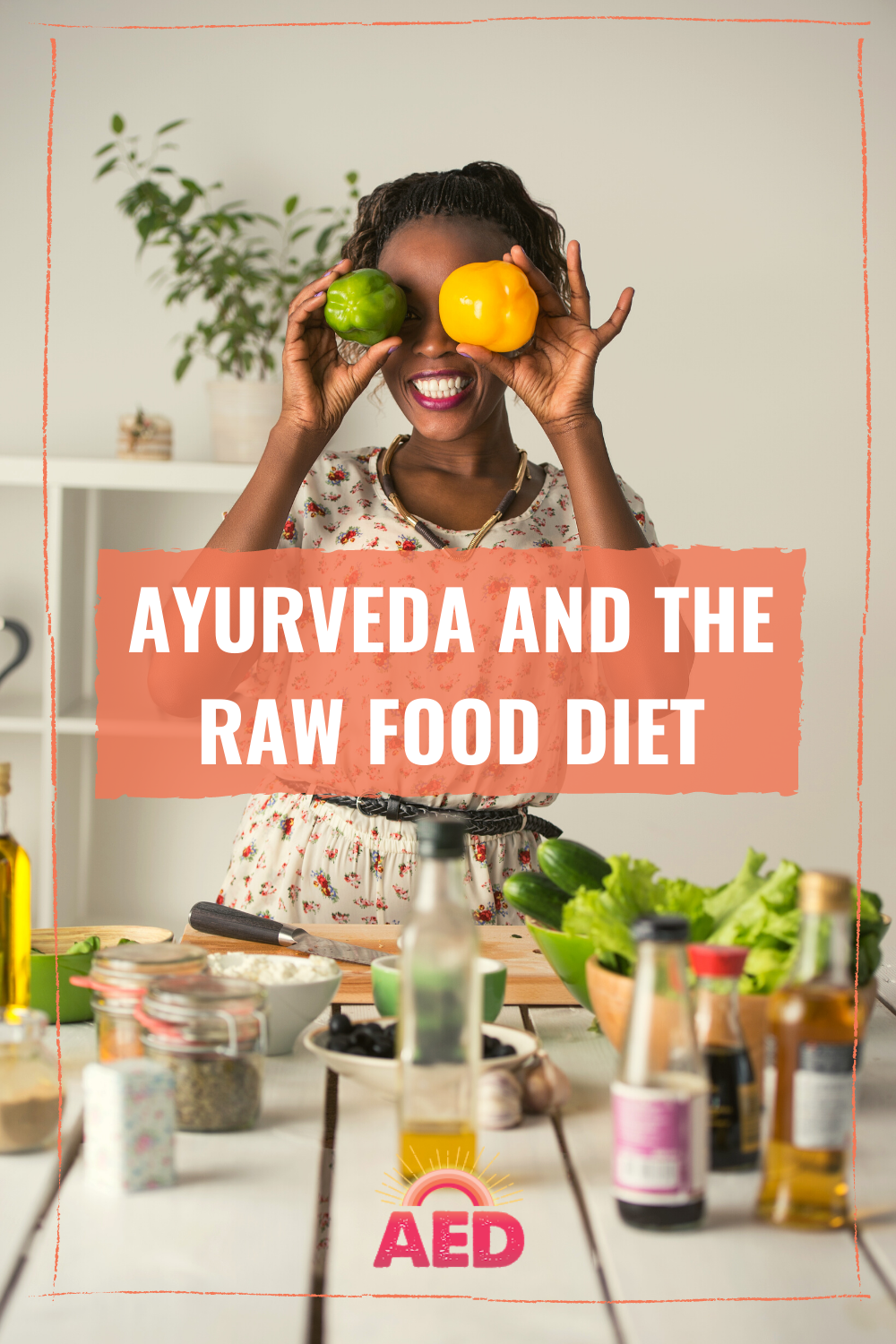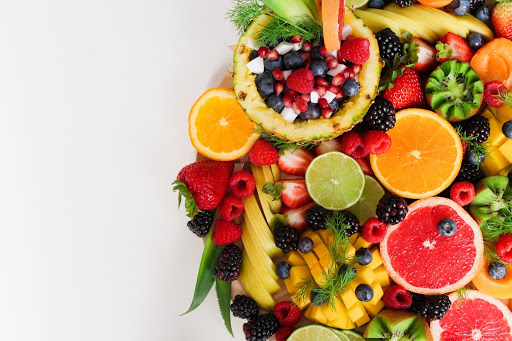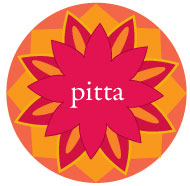
Summer is here! Some of you might already have your fans out and running. Others may be contemplating whether or not putting your bra in the freezer is actually a good summer hack. (Side note: it totally is!)
As you try to find ways to cool down this season, it’s important not to overlook the power of eating a cooling diet.

I’m sure you’ve heard about the raw food diet. You may even be wondering if it’s the right diet for you.
Obviously, it’s an awesome way to beat the heat, but what does Ayurveda have to say about eating raw foods?
Is it really good for everyone?
Let’s talk about it!
The Benefits of a Raw Food Diet
Ayurveda puts an emphasis on cooking food. When we apply the element of fire to our food (real fire, not microwaves), it begins the process of metabolic breakdown and can even release important nutrients from some foods and herbs, making them easier for your body to access and assimilate.
Still, there are many positive aspects to eating a raw food diet.
- Raw food can raise your vibration, helping you to feel light and fresh
- Fruits and veggies that are raw are high in nutrition and enzymes
- A diet that is raw could aide in weight loss
- It’s high in oxygenating Prana, or life force energy
- Foods that are raw are amazing for detoxification and cleansing
A raw food diet may improve heart health

Take a Look Around…
Whatever specific climate you live in, your body’s directly affected by your environment.
This is because you are a microcosm in the macrocosm which means that your body will reflect the nature of your surroundings (in some form or another).

For those of you living in more tropical climates where the weather is especially warm and wet, you may have an easier time digesting raw food because the climate itself lends digestive support to the body and metabolizing drier, cooler foods.
On the flip side, if you live in a cold climate and tend to run cold, you need cooked food regularly – food that helps you cultivate warmth from the inside out.
This rule also applies to the seasons.
As the season’s change and your outside world begins to heat up, you might start to notice more internal heat as well.
Incorporating the cooling elements of a raw diet can help you find balance.
Raw Food and Your Dosha
There’s no specific diet that is going to be good for every person.
According to Ayurveda, health begins in the gut. This means that it’s important to look at how a raw food diet will affect digestion based on your Dosha.
Let’s venture inside of the body, where we can see that there is a lot more to this whole raw food thing than meets the eye.
What’s your Dosha?
If you aren’t sure what your dominant dosha is, then click here to get a snapshot of your ayurvedic blueprint for free.
Vata Dosha
Some of the qualities of Vata include cold, light, and dry. Because a raw food diet is predominantly cool in nature, it has the potential to cause chronic vata derangement in the colon which could cause constipation.
For this reason, it is not recommended that vata dominant people take on a raw food diet. That’s not to say that they can’t eat raw food.
Make sure that at least 75% of your diet is warm, wet, and cooked to maintain balance. If you do want to try on some raw food during the day, do it when the heat of the day is strongest – between 10 am and 2 pm.
Pitta Dosha
Digestion is typically a strong suit for pitta dominant people, so they can tolerate raw and uncooked foods better than most. If you’re pitta dominant or even have excess heat in the body, then a raw diet is going to be right up your alley.
Still, you’ll want to make sure you are choosing the proper fruits, vegetables, and herbs that balance pitta instead of increasing or decreasing it. You can look to an ayurvedic food list to learn more about what those specific foods are.
Kapha Dosha
When Kapha is in excess, your metabolism is more likely to slow down and digestion can feel heavy, sluggish, and slow.
A raw food diet could be super helpful for balancing kapha, but you have to keep in mind that the cold quality of raw food could also potentially aggravate kapha.
Because of this, you’ll want to make sure that you are incorporating pungent spices and some warming foods to make sure you stay balanced.
Finding a middle ground

“To determine how much raw food is right for your diet, pay attention to the strength of your digestion.” – Crystal Ketterhagen, Yoga Journal
Now you know that some Doshas do better with a raw food diet than others.
It’s also important to make sure you are eating cooked foods every now and then. This is because cooking your food serves as a powerful step in the digestion process. The body works much harder to break down raw food than it does the food that has been cooked.
You might consider eating raw and cooked food together.
One thing I love to teach (and practice) is tempering the cold/dry energy of raw food with spices and fresh herbs like ginger, garlic, basil, cinnamon, and cardamom.
If you’re in need of some raw food diet recipes, then I’ve got you covered below!
Easy Ayurvedic Raw Food Recipes
Raw Food Recipe for Pitta Dosha
Fresh Cucumber Raita
VP-K+
Prep Time: 1 hour, 10 minutes
1 medium cucumber, peeled, seeded and grated
1 ½ cups plain coconut yogurt
¼ cup fresh cilantro or dill, chopped fine
1 teaspoon whole cumin seed
½ teaspoon mineral-rich salt
1 teaspoon ground coriander
½ teaspoon ground turmeric
- Peel, seed and grate the cucumber.
- Put the cucumber in a colander or fine-mesh strainer and press to extract excess water. Set aside.
- Add the cucumber in a large mixing bowl with the remaining ingredients. Mix well.
- Refrigerate for 1 hour before serving.
Vata friendly Raw Food Recipe
Indian Spiced Guacamole
V-PK=
Prep Time: 15 minutes
Yield: About 1 ½ cups
2 large avocados, pitted, peeled, and mashed
1 Tablespoon olive oil
Juice of ½ lime or lemon
1 teaspoon mineral-rich salt
1 teaspoon brown mustard seeds
½ teaspoon ground cinnamon
1 teaspoon ground cumin or turmeric
½ teaspoon ground cardamom
1 teaspoon ground coriander
½ teaspoon ground black pepper
1/8 teaspoon cayenne pepper
¼ cup fresh basil leaves, minced
- Cut the avocados in half lengthwise. Remove the seeds and spoon the avocado meat into a medium-sized bowl. Mash with a fork until creamy.
- Stir in the olive oil, lime, salt, and spices.
- Mix in the basil & serve. This guacamole is delicious with Jicama chips, wrapped inside warm tortillas with sprouts, paired with raw radishes and celery sticks, and as a tapenade for raw fish such as tuna or salmon (sushi-grade, of course).
Raw Food Recipe for Kapha Dosha
Fresh Mint Chutney
VK-P=
Prep Time: 10 minutes
Yield: About 1 cup
1 ½ cups fresh mint leaves, de-stemmed and chopped
½ cup fresh cilantro or parsley, chopped
¼ cup unsweetened, shredded coconut
2 Tablespoons raw hempseeds
½ teaspoon mineral-rich alt
2 Tablespoons fresh lemon juice
1 Tablespoon fresh ginger root, grated
2 teaspoons raw honey
½ cup young coconut juice
1 teaspoon whole cumin or fenugreek seed
- Combine all the ingredients together in a food processor or high-speed blender.
- Sweeten and salt to taste.
Still not for certain if a raw food diet is a right choice for you? Take my free dosha quiz to get clarity.
Happy eating!





Thank you for this article.
I am predominately Vata and unfortunately, tend to be out of balance
because of some health issues. I do understand Vatas do best on cooked.
I love fruit and it’s hard for me not to eat a lot of fruit in the summer.
Mangos, watermelon, grapes… how much fruit is appropriate for a Vata to eat. Needless to say, I’m not going to cook the above fruit. I always appreciate what you have to say and the Ayurveda philosophy and lifestyle makes sense to me.
Thank you.
Hey beautiful! yes, I’m Vata predominant, too and even during a MASSIVE Maui heat wave, I had to supplement my (temporary Hawaiian) raw food diet with some cooked grub. Vata does best with sweet, juicy, enzymatic fruits. Mangos are perfect! And for the watermelon, sprinkle it with salt and Chat Masala. YUM!